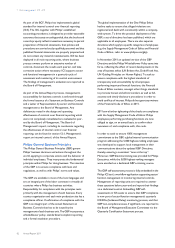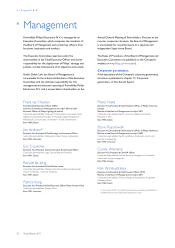Philips 2011 Annual Report Download - page 85
Download and view the complete annual report
Please find page 85 of the 2011 Philips annual report below. You can navigate through the pages in the report by either clicking on the pages listed below, or by using the keyword search tool below to find specific information within the annual report.7 Risk management 7.3 - 7.3
Annual Report 2011 85
7.3 Strategic risks
As Philips’ business is global, its operations are exposed
to economic and political developments in countries
across the world that could adversely impact its revenues
and income.
Philips’ business environment is influenced by conditions
in the domestic and global economies. Although the
macroeconomic environment showed further overall
improvement in the first half of 2011, the development of
certain economic indicators as well as the recent
turbulences in the financial markets in the second half of
2011, primarily as a result of the ongoing sovereign debt
crisis in the Eurozone, still indicate a highly volatile
macroeconomic environment. Future macroeconomic
development is dependent upon the evolution of a
number of global and local factors such as the crisis in the
credit markets, economic crises arising from sovereign
debt overruns, and the related government budget
consolidation and monetary policy measures, including in
the US, Italy, Greece and other European countries. As a
result, reduced levels of capital expenditures, declining
consumer and business confidence, increasing
unemployment in certain countries, fluctuating
commodity prices, bankruptcies, natural disasters,
political crises and other challenges affecting the speed of
sustainable macroeconomic growth, may lead to lower
demand and more challenging market environments
across our sectors. Political developments, such as
healthcare reforms in various countries (e.g. the US
Healthcare Reform) may impose additional uncertainties
by redistributing sector spending, changing reinbursement
models and fiscal changes.
Numerous other factors, such as the fluctuation of energy
and raw material prices, as well as global political conflicts
in North Africa, the Middle East and other regions, could
continue to impact macroeconomic factors and the
international capital and credit markets. Economic and
political uncertainty may have a material adverse impact
on Philips’ financial condition or results of operations and
can also make it more difficult for Philips to budget and
forecast accurately. Philips may encounter difficulty in
planning and managing operations due to unfavorable
political factors, including unexpected legal or regulatory
changes such as foreign exchange import or export
controls, increased healthcare regulation, nationalization
of assets or restrictions on the repatriation of returns
from foreign investments and the lack of adequate
infrastructure. Given that growth geographies are
becoming increasingly important in Philips’ operations,
the above-mentioned risks are also expected to grow and
could have an adverse impact on Philips’ financial
condition and operating results.
Philips may be unable to adapt swiftly to changes in
industry or market circumstances, which could have a
material adverse impact on its financial condition and
results.
Fundamental shifts in the industry, like the transition from
traditional lighting to LED lighting, may drastically change
the business environment. If Philips is unable to recognize
these changes in good time, is too inflexible to rapidly
adjust its business models, or if circumstances arise, such
as pricing actions by competitors, then growth ambitions,
financial condition and operating results could be affected
materially.
Acquisitions could expose Philips to integration risks and
challenge management in continuing to reduce the
complexity of the company.
Philips has recently completed acquisitions, and may
continue to do so in the future, exposing Philips to
integration risks in areas such as sales and service force
integration, logistics, regulatory compliance, information
technology and finance. Integration difficulties and
complexity may adversely impact the realization of an
increased contribution from acquisitions. Philips may
incur significant acquisition, administrative and other
costs in connection with these transactions, including
costs related to the integration of acquired businesses.
Furthermore, organizational simplification and resulting
cost savings may be difficult to achieve. Acquisitions may
also lead to a substantial increase in long-lived assets,
including goodwill. Write-downs of these assets due to
unforeseen business developments may materially
adversely affect Philips’ earnings, particularly in
Healthcare and Lighting which have significant amounts of
goodwill (see also note 9, Goodwill).
Philips may not control joint ventures or associated
companies in which it invests, which could limit the ability
of Philips to identify and manage risks.
Philips has invested or will invest in joint ventures or
associated companies in which Philips will have a non-
controlling interest. In these cases , Philips has limited
influence over, and limited or no control of, the
governance, performance and cost of operations of joint
ventures or associated companies. Some of these joint
ventures or associated companies may represent
significant investments. The joint ventures and associated
companies that Philips does not control may make
business, financial or investment decisions contrary to
Philips’ interests or decisions different from those which
























